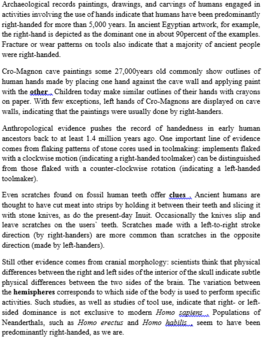Read the following passage and mark the letter A, B, C, or D on your answer sheet to indicate the correct answer to each of the questions from 36 to 42.
THE DIGITAL DIVIDE
Information technology is influencing the way many of us live and work today. We use the Internet to look and apply for jobs, shop, conduct research, make airline reservations, and explore areas of interest. We use e-mail and the Internet to communicate instantaneously with friends and business associates around the world. Computers are commonplace in homes and the workplace.
Although the number of Internet users is growing exponentially each year, most of the world’s population does not have access to computers or the Internet. Only 6 percent of the population in developing countries are connected to telephones. Although more than 94 percent of U.S. households have a telephone, only 42 percent have personal computers at home and 26 percent have Internet access. The lack of what most of us would consider a basic communications necessity –the telephone –does not occur just in developing nations. On some Native American reservations only 60 percent of the residents have a telephone. The move to wireless connections may eliminate the need for telephone lines, but it does not remove the barrier to equipment costs.
Who has Internet access? Fifty percent of the children in urban households with an income over $75,000 have Internet access, compared with 2 percent of the children in low-income, rural households. Nearly half of college-educated people have Internet access, compared to 6 percent of those with only some high school education. Forty percent of households with two parents have access; 15 percent of female, single-parent households do. Thirty percent of white households, 11 percent of black households, and 13 percent of Hispanic households have access. Teens and children are the two fastest-growing segments of Internet users. The digital divide between the populations who have access to the Internet and information technology tools is based on income, race, education, household type, and geographic location. Only 16 percent of the rural poor, rural and central city minorities, young householders, and single parent female households are connected..
Another problem that exacerbates these disparities is that African-Americans, Hispanics, and Native Americans hold few of the jobs in information technology. Women hold about 20 percent of these jobs and are receiving fewer than 30 percent of the computer science degrees. The result is that women and members of the most oppressed ethnic groups are not eligible for the jobs with the highest salaries at graduation. Baccalaureate candidates with degrees in computer science were offered the highest salaries of all new college graduates in 1998 at $44,949.
Do similar disparities exist in schools? More than 90 percent of all schools in the country are wired with at least one Internet connection. The number of classrooms with Internet connections differs by the income level of students. Using the percentage of students who are eligible for free lunches at a school to determine income level, we see that nearly twice as many of the schools with more affluent students have wired classrooms as those with high concentrations of low-income students.
Access to computers and the Internet will be important in reducing disparities between groups. It will require greater equality across diverse groups whose members develop knowledge and skills in computer and information technologies. If computers and the Internet are to be used to promote equality, they will have to become accessible to populations that cannot currently afford the equipment which needs to be updated every three years or so. However, access alone is not enough. Students will have to be interacting with the technology in authentic settings. As technology becomes a tool for learning in almost all courses taken by students, it will be seen as a means to an end rather than an end in itself. If it is used in culturally relevant ways, all students can benefit from its power.
What can be inferred from paragraph 6 about Internet access?
A. The cost of replacing equipment is a problem
B. Technology will be more helpful in three years
C. Better computers need to be designed
D. Schools should provide newer computers for students








Đáp án A
Thông tin: If computers and the Internet are to be used to promote equality, they will have to become accessible to populations that cannot currently afford the equipment which needs to be updated every three years or so..
Dịch nghĩa: Nếu máy tính và Internet sẽ được sử dụng để thúc đẩy sự bình đẳng, chúng sẽ phải trở nên dễ tiếp cận với các nhóm dân số hiện không có khả năng chi trả cho thiết bị mà cần được cập nhật mỗi ba năm hoặc lâu hơn.
Như vậy có thể suy ra rằng người sử dụng không chỉ phải mua thiết bị mà còn phải tốn chi phí để nâng cấp, sửa chữa định kì.
Phương án A. The cost of replacing equipment is a problem = khiến con họ mất niềm tin vào họ, là phương án chính xác nhất.
B. Technology will be more helpful in three years = Công nghệ sẽ hữu ích hơn trong ba năm.
Không có thông tin như vậy trong bài.
C. Better computers need to be designed = máy tính tốt hơn cần phải được thiết kế.
Không có thông tin như vậy trong bài.
D. Schools should provide newer computers for students = Các trường học cần cung cấp máy tính mới dành cho sinh viên.
Không có thông tin như vậy trong bài.